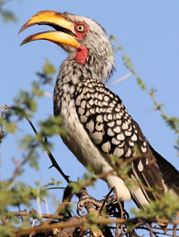

7th June 2022 (6 Topics)
Context
The southern yellow-billed hornbill has been unable to reproduce successfully, and its population has since plummeted.
Key Findings of the Study
- Climate change has been causing havoc on a variety of animals for quite some time. Some have even become extinct.
- It is currently affecting the southern yellow-billed hornbill (Tockus leucomelas), which lives in southern Africa's Kalahari Desert.
- According to recent research, rising temperatures may cause the hornbill to vanish from sections of the Kalahari by 2027.
How climate change is taking a toll on the species?
- In the Kalahari, air temperatures have already risen by more than 2°C in recent decades. At the current rate, by 2027, these birds will no longer reproduce at this location.
- The hornbills failed to reproduce when the daily maximum temperature exceeded 35.7 degrees Celsius (96.3 Fahrenheit).
- When comparing the first three monitoring seasons (2008-2011) to the final three (2016-2019), the average proportion of nest boxes occupied fell from 52% to 12%.
- Nest success, defined as a breeding effort that successfully raises at least one chick, decreased from 58% to 17%.
- Fledglings generated in each breeding attempt decreased from 1.1 to 0.4.
About
- The bird is well known for its peculiar mating and nesting behaviors, in which the female shuts herself within a hole for around 50 days to brood and care for their chicks.
- They eat insects, spiders, and scorpions, as well as seeds they locate on the ground.
- The southern yellow-billed hornbill has a similar appearance to its sister species, the red-billed hornbill (Tockus erythrorhynchus).

Distribution:
- Continents: Africa
- Countries: South Africa, Angola, Botswana, Malawi, Namibia, Zambia, and Zimbabwe.
- Regions: Eswatini
- Biogeographical realms: Afrotropical

|
Kalahari Desert:
|


